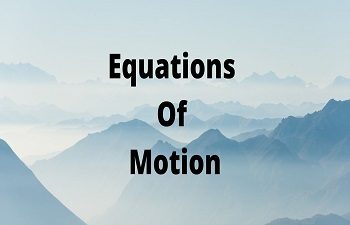Table of Contents
Equations Of Motion:
To determine the velocity ‘ν’ of a body moving with a uniform acceleration ‘a’ in any interval of time ‘t’
Suppose that a body moving along a straight line has an initial velocity ‘μ’ ft / sec and acceleration ‘a’ ft / sec2.
Now,
Velocity of the body after one second = (μ + a) ft / sec
Velocity of the body after two seconds = (μ + 2a) ft / sec
Velocity of the body after five seconds = (μ + 5a) ft / sec
Velocity of the body after ‘t’ seconds = (μ + at) ft / sec
Velocity after ‘t’ seconds is the final velocity (ν ft / sec) acquired by the body.
Hence, ν = μ + at
This relation can also be derived as follows-
Suppose that the velocity of a body changes from initial velocity of ‘μ’ ft / sec to a final velocity ‘ν’ ft / sec in the time ‘t’ seconds. Thus,
Change in velocity in time ‘t’ seconds = (ν – μ) ft /sec
When this change is uniform, the change in velocity per sec = (ν – μ) / t
Since the rate of change of velocity per second is the accelertaion of a moving body,
Therefore, Acceleration, a = (ν – μ) / t
or ν – μ = at
or ν = u + at …………..(i)
In case of retardation, this formula becomes
ν = u – at …………………(ii)
To determine the distance travelled by a moving body having uniform acceleration
Suppose a body moving with an initial velocity of ‘μ’ ft / sec acquires a final velocity of ‘ν’ ft / sec after ‘t’ seconds.
Now if the body moves with a uniform acceleration, its average velocity is given by the relation,
Average Velocity = u + ν / 2 ft /sec
If ‘s’ is the total distance covered by the body in ‘t’ seconds, then we have,
Average Velocity = Total Distance Covered / Total Time Taken
u + ν / 2 ft /sec = s / t ft /sec
i.e. u + ν / 2 = s / t
But ν = u + at
Therefore, s / t = u + u + at / 2 = u + 1/2 at
or s = ut + 1/2 at2 …………………..(iii)
In case of retardation, the equation (iii) becomes,
s = ut – 1/2 at2 ……………………….(iv)
When the body starts from the position of rest, its initial velocity is zero and then the equation (iii) becomes,
s = 1/2 at2 …………………………(v)
To determine the velocity acquired by a body when it describes a distance ‘s’ with uniform acceleration ‘a’
We know:
ν = u + at …………….(x)
s = ut + 1/2 at2 ……………(y)
From the equation (x), t = ν – u / a
Substituting the value of ‘t’ in the equation (y),
s = u (ν – u / a) + 1/2 a (ν – u / a)2
s = uν – u2 / a + 1/2 a (ν2 + u2 – 2uν / a2)
s = uν – u2 / a + ν2 + u2 – 2uν / 2a
s = 2uν – 2u2 + ν2 + u2 – 2uν / 2a
s = ν2 – u2 / 2a
or 2as = ν2 – u2
Therefore, ν2 = u2 + 2 as ……………….(vi)
In case of retardation, the equation (vi) becomes,
ν2 = u2 – 2 as ………………………(vii)
Bodies falling to the Earth
The acceleration of a body due to gravity is denoted by ‘g’. It value in C.G.S system and F.P.S system is 981 cm / sec2 and 32 ft / sec2 respectively. The value of ‘g’ is positive for the bodies falling towards the earth and it is negative for the bodies thrown vertically upwards. Thus, the equations of motion (i), (iii) and (vi), in the case of falling bodies, can be written as-
ν = u + gt
h = ut + 1/2 gt2
ν2 = u2 + 2 gh
- Discovery of Electron Proton Neutron
- Dalton Atomic Theory
- Equilibrium and its State
- Centre of Gravity
- Moment of a Force and Couple
- Flotation of Bodies
- Relative Density and Specific Gravity
- Electrochemistry Notes From Tamil Board









Comments (No)